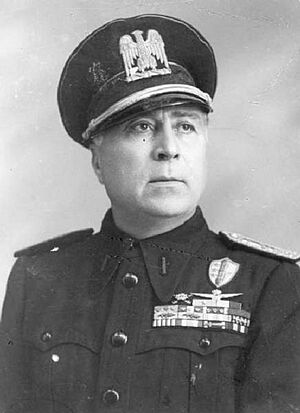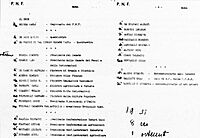Roberto Farinacci facts for kids
Quick facts for kids
Roberto Farinacci
|
|
|---|---|
 |
|
| Secretary of the National Fascist Party | |
| In office 15 February 1925 – 30 March 1926 |
|
| Preceded by | Quadrumvirate |
| Succeeded by | Augusto Turati |
| Member of the Chamber of Deputies | |
| In office 11 June 1921 – 5 August 1943 |
|
| Constituency | at-large |
| Personal details | |
| Born | 16 October 1892 Isernia, Kingdom of Italy |
| Died | 28 April 1945 (aged 52) Vimercate, Kingdom of Italy |
| Cause of death | Executed by firing squad |
| Political party | PSRI (1914–1919) FIC (1919–1921) PNF (1921–1943) PFR (1943–1945) |
| Height | 1.74 m (5 ft 9 in) |
| Spouse |
Anita Bertolazzi
(m. 1910) |
| Profession | Journalist, soldier |
| Military service | |
| Allegiance | |
| Branch/service | |
| Years of service | 1916–1917; 1936 |
| Rank |
|
| Unit | 3rd Telegraphist Regiment Blackshirts |
| Battles/wars | |
Roberto Farinacci (born October 16, 1892 – died April 28, 1945) was an important Italian politician. He was a key member of the National Fascist Party before and during World War II. He was known for his strong support of Nazi Germany. Historian Christopher Hibbert described him as very supportive of Germany.
Contents
Early Life and Rise to Power
Roberto Farinacci was born in Isernia, Italy. He grew up in a poor family and left school when he was young. In 1909, he moved to Cremona and started working on the railroad.
Around this time, he became a socialist who believed Italy should get back lands where Italians lived. He strongly supported Italy joining World War I. After the war, Farinacci became a big supporter of Benito Mussolini and his Fascist movement.
He became known as the Ras (a local leader, like a chief) of the Fascists in Cremona. He started a newspaper called Cremona Nuova. He also created groups of Blackshirts in 1919. These groups were very strong in Cremona. Farinacci used them to make sure people followed Fascist rules. In 1922, he made himself the mayor of Cremona.
Becoming a Key Leader
Farinacci quickly became one of the most powerful members of the National Fascist Party. Many people supported him. He was part of the more extreme side of the party. Some people thought Mussolini was too soft, and Farinacci was seen as very tough.
Farinacci held very strong, negative views about certain groups of people. Despite this, his career continued to grow. He played a big part in helping the Fascists take control of Italy. This happened during and after the 1922 March on Rome.
In 1925, Mussolini made Farinacci the secretary of the party. This made him the second most powerful person in Italy. Mussolini used Farinacci to make the party stronger and more organized. After this, Farinacci was removed from his top role. He worked as a lawyer for several years. In 1929, a magazine called Time called him the "castor oil man" of Fascism. This was because he made opponents of Fascism drink castor oil.
In 1935, Farinacci fought in the Second Italo-Ethiopian War. He was part of the Blackshirts, which were now called the Voluntary Militia for National Security (MVSN). He became a lieutenant general. During this war, he lost his right hand in an accident while fishing with a hand grenade. Later that year, he joined the Grand Council of Fascism. This brought him back into national politics. In 1937, he fought in the Spanish Civil War. In 1938, he became a government minister. He helped put in place laws that separated people based on their background.
Role in World War II
When World War II started, Farinacci supported Nazi Germany. He often talked with the Nazi Party leaders. He advised Mussolini on Italy's dealings with Germany. Farinacci strongly encouraged Mussolini to join the war on the side of the Axis powers. In 1941, he became an inspector for the militia in Albania, which Italy had taken control of.
In July 1943, Farinacci was at a meeting of the Grand Council of Fascism. This meeting led to Mussolini losing power. Most of the council voted against Mussolini, but Farinacci supported him. After Mussolini was arrested, Farinacci went to Germany to avoid being arrested himself.
The Nazi leaders thought about making Farinacci the head of a new Italian government in Northern Italy. But they chose Mussolini instead, after he was rescued by Otto Skorzeny in September. After this, Farinacci went back to Cremona. He did not take an active part in politics anymore. However, he kept writing political articles. He also helped fund a journal called Crociata Italica.
Capture and Death
On April 26, 1945, near the end of World War II, Farinacci left Cremona. He was trying to get to Valtellina with a small group of Fascist supporters. Near Bergamo, he left the main group. He went towards Vimercate with a woman named Maria Carolina Vidoni Soranzo.
On April 27, their car met a group of partisans near Brivio. Farinacci's car did not stop, and there was a shootout. The driver was killed, and the woman with him was badly hurt. Farinacci was not hurt and was captured. He had twelve suitcases full of money and jewels.
He was taken to the town hall in Vimercate. There, he was put on trial by a partisan court. He asked to be taken to Cremona, saying people there would say he was a good person. He denied all the accusations against him. There was some debate about what to do with him. Some wanted to hand him over to the Allies. Others wanted to execute him. In the end, he was sentenced to death. He was executed in the main square of Vimercate on April 28, 1945.
Roberto Farinacci was one of the most important Fascist voices who promoted negative views about Jewish people during Mussolini's rule.
Images for kids



